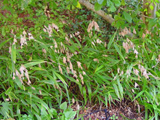Native Plants

Q. Who is Mr. Smarty Plants?
A: There are those who suspect Wildflower Center volunteers are the culpable and capable culprits. Yet, others think staff members play some, albeit small, role. You can torture us with your plant questions, but we will never reveal the Green Guru's secret identity.
Did you know you can access the Native Plant Information Network with your web-enabled smartphone?
Ask Mr. Smarty Plants is a free service provided by the staff and volunteers at the Lady Bird Johnson Wildflower Center.

rate this answer
Wednesday - August 28, 2013
From: Florence, KY
Region: Mid-Atlantic
Topic: Erosion Control, Shade Tolerant
Title: Erosion control for shady slope in Kentucky backyard
Answered by: Nan Hampton
QUESTION:
I live in northern Kentucky (near Cincinnati). I have an area in my backyard that has slope. It is next to an ash tree and is very shady. Water erosion has washed away the top soil and pretty much nothing will grow there. I have tried planting periwinkle and ferns but they haven't done well, I think because the soil is too nutrient deficient. I have tried composting with dead leaves and grass clippings but when it rains, the water washes that away too. Any suggestions?ANSWER:
The best solution may be erosion control blankets to stabilize the erosion area. The erosion-control fabric works by slowing the runoff water and allowing sediments to fall out rather than be washed away. Seeds are sown under the erosion-control material and grow up through the matting when they germinate. You can also insert plants into the soil by cutting through the matting. The roots of the plants that are growing through the erosion-control material anchor the soil to stop the erosion. If you use erosion-control blankets made of biodegrable material, they will eventually disappear leaving the plants to control the problem. You could add your dead leaves, grass clippings and, perhaps, some topsoil underneath the blanket. These blankets are available at some larger nurseries and "big box" stores. Search on the internet for locations near you. Now, here are some recommendations for native shade-loving plants to try for the area. These all can be found occurring in Boone County or in adjacent areas.
GRASS/GRASS-LIKE (Grasses and sedges have fibrous root systems that help hold soil in place.)
Carex blanda (Eastern woodland sedge)
Carex pensylvanica (Pennsylvania sedge)
Carex plantaginea (Plantainleaf sedge)
Danthonia spicata (Poverty oatgrass) will grow in the shade and poor soil. Here are photos and more information from Illinois Wildflowers.
Chasmanthium latifolium (Inland sea oats)
Sorghastrum nutans (Indiangrass)
PERENNIAL SHRUBS
Ceanothus americanus (New jersey tea) has massive, deep roots to help prevent erosion.
Heuchera americana (American alumroot) tolerates poor soil.
Gaylussacia baccata (Black huckleberry)
FERNS (There are other possibilities for ferns, but these two are good choices.)
From the Image Gallery
More Erosion Control Questions
Plants to stabilize a bank in VT
April 10, 2012 - I am looking for suggestion on what plants might best be suited for aiding in the stabilization of a very steep bank above Lake Champlain.
view the full question and answer
Plantings for a slope from New Carrollton MD
June 27, 2012 - My house (Maryland, near DC) sits at the bottom of a south facing slope. The soil is very heavy clay. The grade is about 1:20 for about 100 feet (with a steeper part at the top). Part of the hill is i...
view the full question and answer
Erosion controlling plants for a shady Minnesota lakeside
August 11, 2015 - I live about 50 yards from a lake and there is a steep embankment. Recently someone decided to cut the trees off the embankment and now the dirt is eroding off the embankment as well as off my back ya...
view the full question and answer
Plants to prevent erosion in clay soil in Heron, NY
September 07, 2009 - What plants could be used to plant on clay soil, Eastern exposure in full sun to stop erosion on a bay side hill with a steep grade?
view the full question and answer
Plants to stop erosion in Alabama
July 03, 2009 - Our front yard is being washed down the street when we have rainstorms. It's been especially bad this year due to all the rain.What kinds of plants/grasses could we use to help stop the water from r...
view the full question and answer
| Support the Wildflower Center by Donating Online or Becoming a Member today. |

